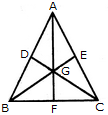Discussion
Home ‣ Non Verbal Reasoning ‣ Analytical Reasoning See What Others Are Saying!
- Question
Find the number of triangles in the given figure.

Options- A. 16
- B. 13
- C. 9
- D. 7
- Correct Answer
- 16
ExplanationThe figure may be labelled as shown.
The simplest triangles are AGE, EGC, GFC, BGF, DGB and ADG i.e. 6 in number.
The triangles composed of two components each are AGC, BGC and ABG i.e. 3 in number.
The triangles composed of three components each are AFC, BEC, BDC, ABF, ABE and DAC i.e. 6 in number.
There is only one triangle i.e. ABC composed of six components.
Thus, there are 6 + 3 + 6 + 1 = 16 triangles in the given figure.
More questions
- 1. Which of the following piece will fit in the figure given below?
Options- A. 1
- B. 2
- C. 3
- D. 4 Discuss
Correct Answer: 4
Explanation:
NA
- 2. NA
Options- A. 1
- B. 2
- C. 3
- D. 4 Discuss
Correct Answer: 3
Explanation:
NA
- 3. NA
Options- A. 1
- B. 2
- C. 3
- D. 4 Discuss
Correct Answer: 1
Explanation:
NA
- 4. NA
Options- A. 1
- B. 2
- C. 3
- D. 4 Discuss
Correct Answer: 1
Explanation:
NA
- 5. NA
Options- A. 1
- B. 2
- C. 3
- D. 4 Discuss
Correct Answer: 1
Explanation:
NA
- 6. NA
Options- A. 1
- B. 2
- C. 3
- D. 4 Discuss
Correct Answer: 2
Explanation:
NA
- 7. NA
Options- A. 1
- B. 2
- C. 3
- D. 4 Discuss
Correct Answer: 4
Explanation:
NA
- 8. NA
Options- A. 1
- B. 2
- C. 3
- D. 4 Discuss
Correct Answer: 4
Explanation:
NA
- 9. From the given alternatives, select the word which CANNOT be formed using the letters of the given word. Demonstration
Options- A. Moon
- B. Most
- C. Train
- D. Damage Discuss
Correct Answer: Damage
Explanation:
- 10. A piece of paper is folded and cut as shown below in the given question figures. From the given answer figures, indicate how it will appear when opened.
Options- A. 1
- B. 2
- C. 3
- D. 4 Discuss
Correct Answer: 3
Explanation:
NA
Comments
There are no comments.
- 1.
Programming
Copyright ©CuriousTab. All rights reserved.
